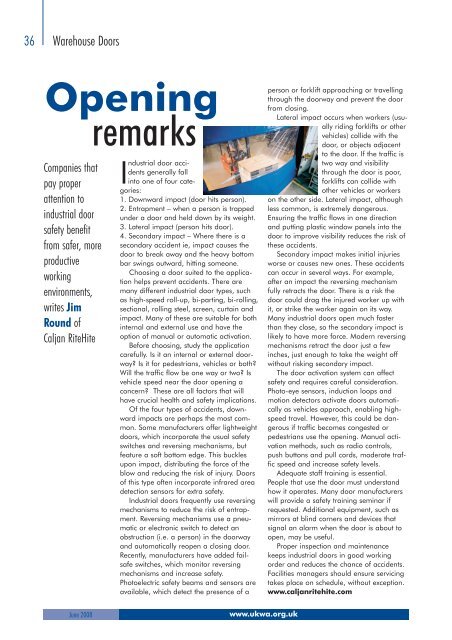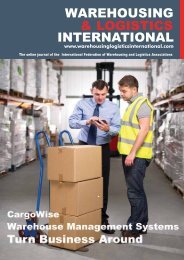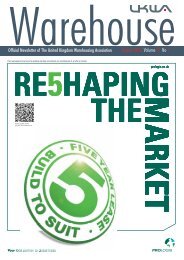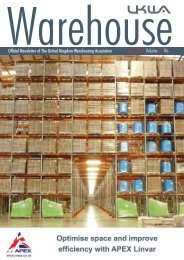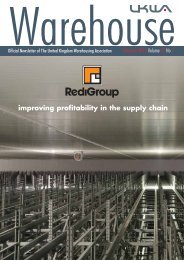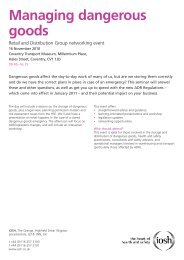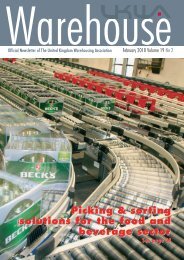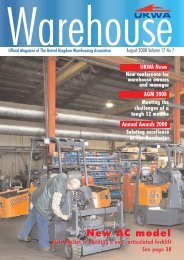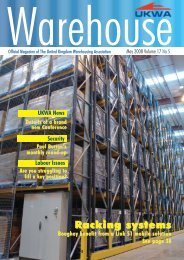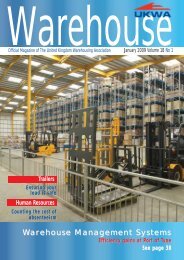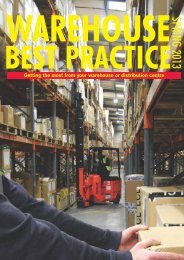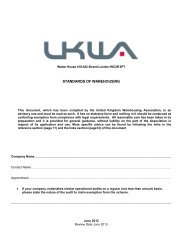UKWA FOR WEB - United Kingdom Warehousing Association
UKWA FOR WEB - United Kingdom Warehousing Association
UKWA FOR WEB - United Kingdom Warehousing Association
Create successful ePaper yourself
Turn your PDF publications into a flip-book with our unique Google optimized e-Paper software.
36 Warehouse Doors<br />
Opening<br />
remarks<br />
Companies that<br />
pay proper<br />
attention to<br />
industrial door<br />
safety benefit<br />
from safer, more<br />
productive<br />
working<br />
environments,<br />
writes Jim<br />
Round of<br />
Caljan RiteHite<br />
Industrial door accidents<br />
generally fall<br />
into one of four categories:<br />
1. Downward impact (door hits person).<br />
2. Entrapment – when a person is trapped<br />
under a door and held down by its weight.<br />
3. Lateral impact (person hits door).<br />
4. Secondary impact – Where there is a<br />
secondary accident ie, impact causes the<br />
door to break away and the heavy bottom<br />
bar swings outward, hitting someone.<br />
Choosing a door suited to the application<br />
helps prevent accidents. There are<br />
many different industrial door types, such<br />
as high-speed roll-up, bi-parting, bi-rolling,<br />
sectional, rolling steel, screen, curtain and<br />
impact. Many of these are suitable for both<br />
internal and external use and have the<br />
option of manual or automatic activation.<br />
Before choosing, study the application<br />
carefully. Is it an internal or external doorway<br />
Is it for pedestrians, vehicles or both<br />
Will the traffic flow be one way or two Is<br />
vehicle speed near the door opening a<br />
concern These are all factors that will<br />
have crucial health and safety implications.<br />
Of the four types of accidents, downward<br />
impacts are perhaps the most common.<br />
Some manufacturers offer lightweight<br />
doors, which incorporate the usual safety<br />
switches and reversing mechanisms, but<br />
feature a soft bottom edge. This buckles<br />
upon impact, distributing the force of the<br />
blow and reducing the risk of injury. Doors<br />
of this type often incorporate infrared area<br />
detection sensors for extra safety.<br />
Industrial doors frequently use reversing<br />
mechanisms to reduce the risk of entrapment.<br />
Reversing mechanisms use a pneumatic<br />
or electronic switch to detect an<br />
obstruction (i.e. a person) in the doorway<br />
and automatically reopen a closing door.<br />
Recently, manufacturers have added failsafe<br />
switches, which monitor reversing<br />
mechanisms and increase safety.<br />
Photoelectric safety beams and sensors are<br />
available, which detect the presence of a<br />
person or forklift approaching or travelling<br />
through the doorway and prevent the door<br />
from closing.<br />
Lateral impact occurs when workers (usually<br />
riding forklifts or other<br />
vehicles) collide with the<br />
door, or objects adjacent<br />
to the door. If the traffic is<br />
two way and visibility<br />
through the door is poor,<br />
forklifts can collide with<br />
other vehicles or workers<br />
on the other side. Lateral impact, although<br />
less common, is extremely dangerous.<br />
Ensuring the traffic flows in one direction<br />
and putting plastic window panels into the<br />
door to improve visibility reduces the risk of<br />
these accidents.<br />
Secondary impact makes initial injuries<br />
worse or causes new ones. These accidents<br />
can occur in several ways. For example,<br />
after an impact the reversing mechanism<br />
fully retracts the door. There is a risk the<br />
door could drag the injured worker up with<br />
it, or strike the worker again on its way.<br />
Many industrial doors open much faster<br />
than they close, so the secondary impact is<br />
likely to have more force. Modern reversing<br />
mechanisms retract the door just a few<br />
inches, just enough to take the weight off<br />
without risking secondary impact.<br />
The door activation system can affect<br />
safety and requires careful consideration.<br />
Photo-eye sensors, induction loops and<br />
motion detectors activate doors automatically<br />
as vehicles approach, enabling highspeed<br />
travel. However, this could be dangerous<br />
if traffic becomes congested or<br />
pedestrians use the opening. Manual activation<br />
methods, such as radio controls,<br />
push buttons and pull cords, moderate traffic<br />
speed and increase safety levels.<br />
Adequate staff training is essential.<br />
People that use the door must understand<br />
how it operates. Many door manufacturers<br />
will provide a safety training seminar if<br />
requested. Additional equipment, such as<br />
mirrors at blind corners and devices that<br />
signal an alarm when the door is about to<br />
open, may be useful.<br />
Proper inspection and maintenance<br />
keeps industrial doors in good working<br />
order and reduces the chance of accidents.<br />
Facilities managers should ensure servicing<br />
takes place on schedule, without exception.<br />
www.caljanritehite.com<br />
June 2008<br />
www.ukwa.org.uk


